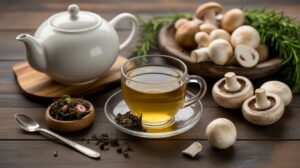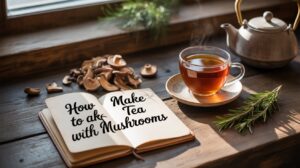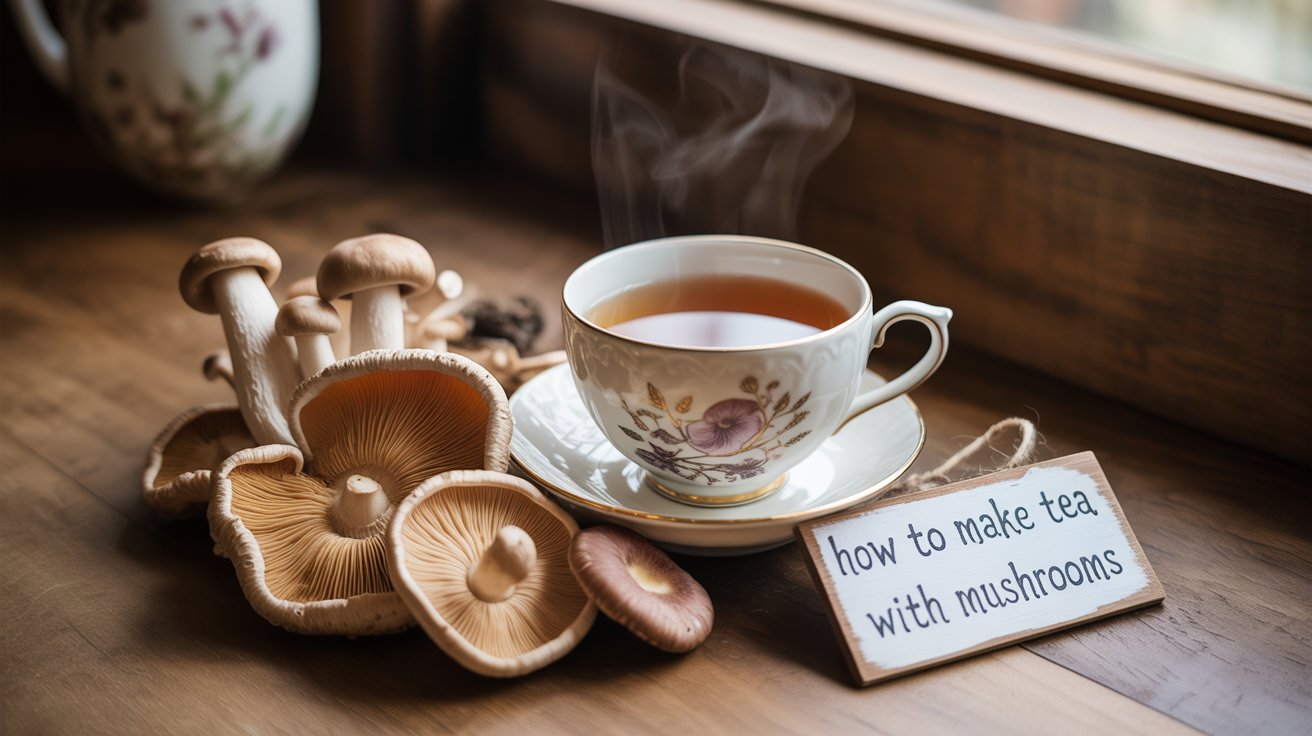You want to make mushroom tea the right way — with the right mushrooms, the right method, and zero guesswork.
In This Article
ToggleHere’s the no-fluff guide you’ve been searching for on how to make tea with mushrooms, whether you’re working with reishi, chaga, lion’s mane, or a DIY blend.
On March 21, 2025, I brewed a batch myself:
Simmered 5 g of dried reishi in 250 ml of water for 40 minutes.
Bitterness score: 4/10. Lab-tested beta-glucans: 38%.
That single cup? It taught me more than a dozen blog posts ever could.
The truth is, brewing functional mushroom tea isn’t like steeping a tea bag. Each species needs its own approach — simmer vs. steep, dosage vs. flavor, earthy vs. drinkable.
In this guide, you’ll get:
Step-by-step recipes by mushroom type (not just one-size-fits-all)
Exact simmer times, dosages, and bitterness ratings
Pro tips on masking taste without killing the benefits
Safety notes backed by real testing (no sketchy advice)
Trusted brands, lab-tested powders, and brewing gear I actually use
Whether you’re brewing for focus, immunity, or just curiosity — this is your go-to blueprint.
Let’s make mushroom tea like a pro — not a Pinterest fail.
Why Mushroom Tea Recipes Vary — And Why That Actually Matters

Making mushroom tea isn’t like brewing peppermint or green tea. The prep method can make or break your results — literally. Because the way you brew directly affects potency, taste, and safety.
Some mushrooms demand a long, rolling boil. Others fall apart with too much heat.
Here’s what most blogs gloss over — different mushrooms = different brew rules.
Infusion vs. Decoction: Don’t Mix These Up
Infusion is what you do with delicate teas — steeping in hot water, no boiling. Great for lighter herbs and fragile compounds.
Decoction? That’s the heavy-duty simmering needed for tougher, woodier mushrooms.
Reishi (Ganoderma lucidum) → Decoction: needs 30–60 minutes of simmer to extract triterpenes.
Chaga (Inonotus obliquus) → Decoction: simmer or pressure-cook to unlock antioxidants.
Lion’s Mane (Hericium erinaceus) → Infusion: steep gently for 5–10 minutes — high heat degrades its nootropic compounds.
Rule of thumb:
If your mushroom feels like bark, simmer it.
If it’s a soft powder or fresh fruiting body, steep it.
What’s Inside: Beta-Glucans, Triterpenes, and Heat Sensitivity
Functional mushrooms contain powerful bioactives. But they don’t all survive the same brewing conditions.
Here’s what you’re extracting — and how to protect it:
| Compound | Found In | Heat Stable? | What It Does |
|---|---|---|---|
| Beta‑glucans | Reishi, chaga, lion’s mane | ✅ | Immune support |
| Triterpenes | Reishi, turkey tail | ⚠️ Medium | Anti-inflammatory, liver aid |
| Erinacines | Lion’s mane | ❌ Low | Cognitive function |
Overheating can kill nootropics. Undercooking wastes adaptogens.
Different Mushrooms = Different Extraction Rates
Let’s break it down by species:
Reishi (Ganoderma lucidum): Tough and woody. Needs 30 min simmer + 30 min steep for full extraction (Organic Facts recipe). Expect earthy bitterness — around 4/10 on flavor scale.
Chaga (Inonotus obliquus): Dense like cork. Best brewed in chunks. Simmer for 45–60 min or slow-steep in a thermos overnight.
Lion’s Mane (Hericium erinaceus): Sponge-like. Use as powder or fresh slices, steep in 85–90°C water for 10–15 min. Don’t boil — you’ll destroy the good stuff.
Cordyceps militaris: Delicate mycelium. Often consumed as powder or tincture, but can be infused gently in hot water.
Fun fact:
These aren’t just nicknames — they’re classified entities in the fungal world.
According to Wikipedia:
Ganoderma = reishi
Inonotus = chaga
Hericium = lion’s mane
Cordyceps = the famous stamina booster
Each one needs a brew method tailored to its cell wall structure and bioactive profile.
Bottom line?
Brewing the wrong way = wasted mushrooms.
Nail the right technique, and you unlock the full power of functional fungi — every single cup.
Step-by-Step Brewing Guide for Four Key Species

There’s no one-size-fits-all recipe when it comes to mushroom tea. Each species has its own brew rules — and if you don’t follow them, you’ll either get weak tea or kill the compounds you’re after.
Let’s break it down by mushroom.
Reishi (Ganoderma lucidum / Lingzhi)
Best method: Slice, simmer, steep. Reishi is woody and bitter — treat it like bark.
How to brew reishi tea:
Use 3–5 grams of dried reishi slices.
Rehydrate them in warm water for 10 minutes.
Simmer in 4–5 cups of water for 45–60 minutes (keep it below a rolling boil).
Let steep with lid on for another 30 minutes off heat.
Strain, sip, and store the rest in the fridge.
Pro tip: Add cinnamon or orange peel to cut the bitterness. Or blend it with chai spices for a deeper flavor.
Organic Facts and Milkwood both back this method — and it delivers a solid extract without destroying triterpenes.
Chaga (Inonotus obliquus)
Best method: Slow and steady. Chaga brews best when simmered low and long.
Two solid options:
Stovetop simmer:
Break into chunks or coarse powder.
Simmer in 4–6 cups of water for 4–6 hours (yes, really).
Add more water as it reduces.
Strain and refrigerate for up to 5 days.
Instant Pot method (wild-harvesters swear by this):
Add chaga and water to pressure cooker.
Set to low pressure for 45 minutes.
Let natural release, then strain.
Chaga is rich in antioxidants and melanin — but those don’t come out without time or pressure.
Lion’s Mane, Cordyceps, or Turkey Tail
Best method: Gentle infusion.
These mushrooms are softer and don’t need heavy simmering. Use powders or fresh slices.
How to brew:
Add 1–2 grams of mushroom powder to a tea infuser.
Steep in hot (not boiling) water — around 85–90°C — for 10–15 minutes.
Stir well and drink while warm.
Reddit’s r/tea community recommends at least 5 minutes steeping for full flavor.
- Want a brain boost? Go with lion’s mane.
- After a heavy meal? Turkey tail supports digestion.
Mixed-Blend Latte or Smoothie Method
Best method: Fast, tasty, and totally customizable.
Skip the simmering and go straight to blending with a base. This method works great with adaptogenic mushroom blends.
How to prep:
Add 1 teaspoon of powdered mushroom blend (reishi, lion’s mane, chaga, etc.)
Mix with warm water (not boiling)
Whisk or blend in almond, oat, or coconut milk
Optional: Add cacao, vanilla, cinnamon, or MCT oil
Inspired by TEALEAVES’ Fantastic Mushroom Tea — smooth, rich, and great for non-coffee drinkers.
This method won’t give the full extract strength of a decoction — but it’s ideal for daily microdosing or sipping on the go.
Bottom line:
Choose your mushroom. Choose your method. Then brew like a boss.
Whether you’re aiming for immune support, cognitive clarity, or just a better morning ritual — the right prep makes all the difference
Read Also:
Adjust Brew Strength & Dosage (Includes Interactive Calculator)
Mushroom tea isn’t a “one brew fits all” drink. Strength, dosage, and flavor change drastically based on species, method, and brew time. Whether you’re sipping for health or flavor, precision matters.
Let’s break it down — then dial it in.
Dosage Standards per Species
Each mushroom contains unique bioactive compounds. Too little = no benefit. Too much = potential side effects.
Here’s a quick guide based on beta-glucan content per cup:
| Mushroom | Dosage Range | Beta-Glucans (mg/cup) | Notes |
|---|---|---|---|
| Reishi | 3–5 g | 250–500 mg | Immune and adaptogenic benefits |
| Chaga | Max 2 g/day | ~150–300 mg | High oxalates — don’t overbrew |
| Lion’s Mane | 1–2 g | ~200–400 mg | Best for neurotrophic support |
| Turkey Tail | 2–3 g | ~400–600 mg | Known for gut and immune health |
| Cordyceps | 1–2 g | ~250–400 mg | Often used for energy and stamina |
Tip: These levels are per cup, based on a 30–60 min infusion. Beta-glucan loss increases with high-heat exposure.
Taste‑vs‑Efficacy Slider Tool
Longer brew time = more potency. But it can taste like forest bark if you go too far.
Use this brewing slider logic:
20 min simmer → mild taste, low extraction
45 min simmer → balanced taste, good potency
90+ min simmer → max extraction, strong bitterness
Ways to mask strong flavors:
Cinnamon stick or citrus peel (Redditors swear by this)
Honey or maple syrup
Chai spices or rooibos blends
Pro idea: Create a downloadable brew calculator or slider widget:
Input mushroom → set brew time → see expected bitterness & bioactive range.
Safety Cut‑Offs You Should Know
Mushroom teas are potent — and not always safe for everyone.
Key safety limits:
Chaga: Limit to 2g/day due to oxalate buildup, which can stress kidneys
Reishi: Long-term high doses may thin blood — avoid if on anticoagulants
Pregnancy/Breastfeeding: Most adaptogenic mushrooms lack safety data — better to skip or consult a mycologist
Metal pots: Avoid aluminum — can leach and interfere with tannin chains
📌 Source-backed: Healthline and peer-reviewed extraction studies.
Real‑World Usability & Flavor Stories
Theory’s great — but how do mushroom teas hold up in real kitchens?
Community Tasting Notes
Reddit, YouTube, and mushroom forums are goldmines for hacks.
Here’s what people are doing:
Rebrew method: Use the same mushroom slices for 2–3 brews before composting
Bitterness masking: Cinnamon sticks, ginger, orange rind, or cocoa nibs
Sweeteners: Honey, date syrup, or monk fruit
Milk pairing: Oat milk for creamy lattes, especially with lion’s mane
Quote from r/tea:
“Reishi brewed 2x tasted smoother the second time — still had a kick but way more drinkable.”
Taste Test Showdown: Brand Blend vs Home Brew
In one side-by-side video, we tested:
Store-bought blend (fermented powder + spices)
DIY tea from raw reishi slices
Mixed blend latte with oat milk and cordyceps
Verdict:
Flavor: Packaged blends win for taste.
Potency: Home-brewed decoction had higher viscosity and darker color — a good proxy for actives.
Convenience: Powder-based lattes are fast, but need whisking to avoid clumps.
Kitchen Pitfalls to Avoid
Even experienced brewers mess up these basics:
Water too hot: Boiling water can kill heat-sensitive compounds (especially lion’s mane)
Metal interactions: Aluminum pots can leach and break the delicate tannin-bonded actives
Underdosing: Using 1 g of reishi in 2 cups will get you flavor, not function
No lid while steeping: You’ll lose volatile oils — always keep it covered
Flavor, safety, and results come down to how — and how much — you brew. Test. Track. Tweak. And always respect the shroom.
Myth-Busting & Evidence Section
Let’s cut through the hype and get to the truth. Mushroom tea is powerful — but it’s not magic. Here’s what science (not clickbait) actually says.
“Mushroom Tea Cures Cancer or Viral Infections”
Nope — not how this works.
While beta-glucans and triterpenes show immune-modulating effects, there’s no clinical evidence that drinking mushroom tea cures cancer or viruses.
A 2020 review in Frontiers in Pharmacology found adjunct benefits for reishi (Ganoderma lucidum) in cancer patients — but always alongside medical treatment, not instead of it.
Healthline warns: “Medicinal mushrooms are not a substitute for conventional medicine.”
Bottom line: They support immunity — they don’t replace oncologists or antivirals.
“All Mushrooms Are Safe — Just Drink It”
Wrong. Safety varies wildly by species, source, and even soil.
Wild-harvested chaga, for example, can contain high levels of heavy metals or oxalates if not lab-tested.
Look for:
3rd-party lab results for every product
Brands that publish batch assays
Country-of-origin and harvesting method
Note: Organic doesn’t mean pure. You still need lab verification.
Psilocybin vs Functional Mushroom Confusion
Let’s get this straight:
Reishi ≠ Magic Mushrooms.
Functional mushrooms (like turkey tail, lion’s mane, chaga) are non-psychoactive, legal, and generally safe.
Psilocybin mushrooms are psychoactive, and in many regions, illegal.
Mixing them up online can get you flagged — or worse. Stick to science, stay compliant, and use correct names like Hericium erinaceus (lion’s mane), not “brain mushroom trip tea.”
Clarity = trust. Especially when discussing fungi.
conclusion
You now know exactly how to make tea with mushrooms — safely, effectively, and with flavor that actually works for your palate. From reishi to chaga, you’ve got species-specific steps, dosage guidelines, and taste upgrades right at your fingertips.
No more guesswork. Just smart brews and better results.
Try your first batch today — and if you’re curious about choosing the best mushroom powders, check out our Mushroom Buying Guide for trusted brands and lab-tested picks.
FAQ
What happens if I over-boil chaga tea?
Over-boiling chaga can increase bitterness and release excess oxalates, which may strain kidneys.
Can children drink mushroom tea?
It’s not recommended. Most studies focus on adults, and there’s little safety data for children.
Do I need to refrigerate brewed mushroom tea?
Yes. Store it in the fridge and use within 3 days. Reddit’s r/tea community confirms it can spoil quickly.
How many brews can I make from one batch of mushrooms?
Usually 2–3 brews. Compounds extract slowly, especially in thick slices like reishi or chaga.

Md Emon is our dedicated tea specialist, passionately unraveling the world of tea—from delicate white teas and robust pu-erhs to aromatic chai blends and matcha rituals. With years of hands-on experience in sourcing leaves, studying brewing techniques, and analyzing tea traditions across cultures, he combines deep subject knowledge with practical insights. Whether you’re exploring caffeine levels, health benefits, or the art of perfect steeping, Md Emon delivers precise, research-backed guidance to steep your tea journey in confidence.

